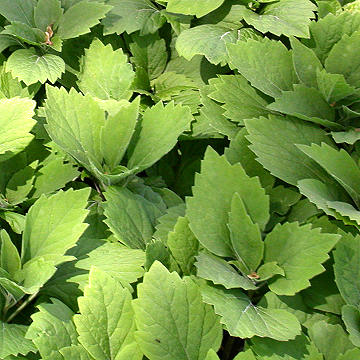

Pachysandra procumbens - (image 1 of 4)
Taxonomy
Family: Buxaceae
Habitat
Rich woods (Gleason & Cronquist 1991). Well-drained, gravelly soils (Dirr 1998).
Associates
Distribution
Southern IN, KY, TN, and WV to northwest FL and southern LA. Naturalized in PA.
Morphology
Semi-evergreen, suffrutescent (woody at the base) herb from a long rhizome. Stems erect, 1.5 to 40 cm long. Leaves gray to blue-green, sometimes gray mottled above, pubescent below, alternate and crowded toward the top of the stem, ovate to rotund, 3-8 cm, coarsely toothed near apex, narrowing to a long petiole.
Monoecious; flowers fragrant, in 1-5 solitary spikes appearing laterally from the base, 5-10 cm long; flowers small, white, hypogenous, apetalous; staminate flowers terminal on the spike with 4 sepals and 4 stamens; pistillate flowers with 4 or more sepals, ovary with 2-3 carpels and 4-6 uniovulate locelli (chambers). Fruit a trilobed, pubescent, circumsissile (dehiscing such that the top comes off as a cap or lid) capsule to 1.5 cm.
Notes
Flowers April to May.
Wetland indicator: NA
Endangered in IN and FL.
A slow-spreading groundcover that is adaptable to partial or full shade. Prefers rich, moist, well-drained soils of acid or neutral pH. Flowers only produced on stems that survive from the previous year. Hardy to USDA Zone 5.
Similar to Japanese Pachysandra (P. terminalis Siebold & Zucc.), a popular groundcover that sometimes escapes. Japanese Pachysandra has leaves that are narrower and shiny green, terminal spikes, white berry-like fruits to 7 mm. Pachysandra is derived from the Greek pakhus (thick) and the Modern Latin -andrus (male, in references to the stamens).
References
Dirr, Michael A.
1998. Manual of Woody Landscape Plants:
Their Identification, Ornamental Characteristics, Culture, Propagation and Uses.
5th ed. Champaign, Illiois: Stipes Publishing L.L.C.
Gleason, Henry A. and A. Cronquist. 1991. Manual of Vascular Plants of Northeastern United States and Adjacent Canada. Second Ed.
The New York Botanical Garden. Bronx, NY
USDA, NRCS. 2002.
The PLANTS Database, Version 3.5 (http://plants.usda.gov).
National Plant Data Center, Baton Rouge, LA 70874-4490 USA.
|
Michael Hough © 2009 |